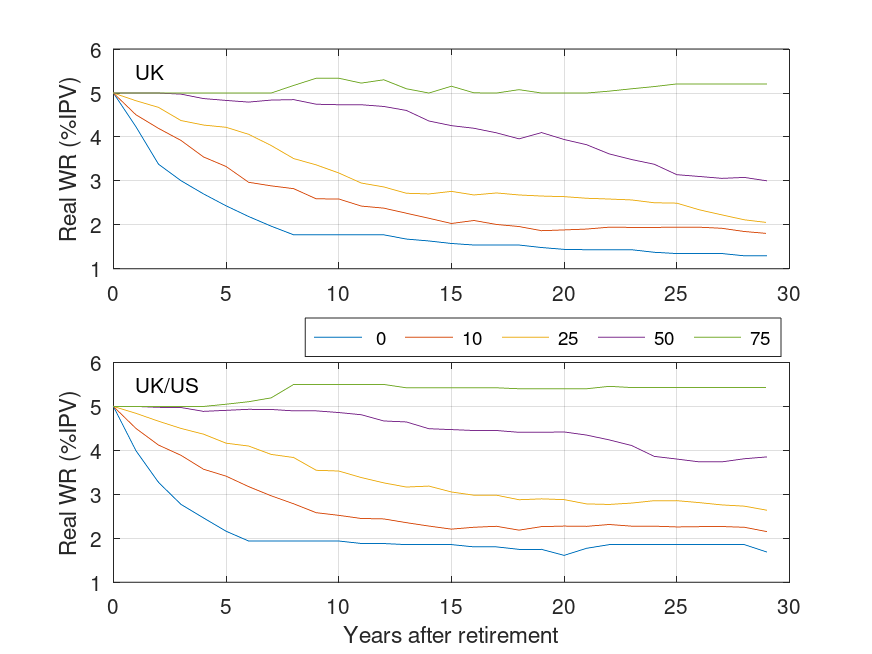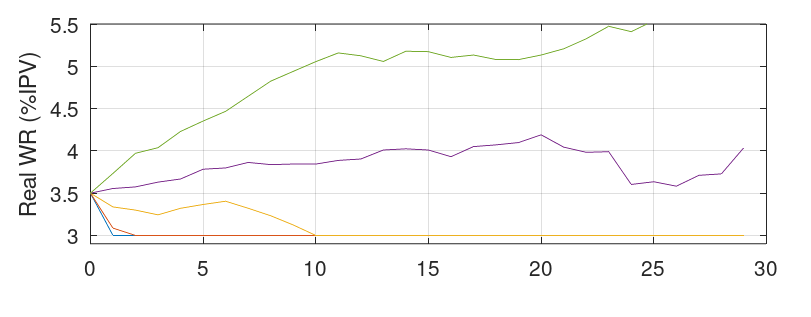We’d like to remind Forumites to please avoid political debate on the Forum.
This is to keep it a safe and useful space for MoneySaving discussions. Threads that are – or become – political in nature may be removed in line with the Forum’s rules. Thank you for your understanding.
Guyton-Klinger withdrawal model
Comments
-
"What is the collective wisdom on this strategy? It certainly seems sensible and common sense."
Superficially great in theory, suboptimal in the real world, hence why (hopefully) few use it.
https://www.kitces.com/blog/guyton-klinger-guardrails-retirement-income-rules-risk-based/
1 -
"wealth at death" - how have you determined when you are going to die?It's just my opinion and not advice.0
-
OldScientist I wonder, would you be willing to do me a favour? Many proponents of GK propose an initial withdrawal rate of 5% or 5.25%. Could you plot those two graphs again with a 5% starting withdrawal. I would love to see the results.OldScientist said:Just to demonstrate what O mean about the difference between portfolios... in the following figure I have plotted the 0th (worst case), 10th, 25th, 50th (median), and 75th percentiles of real withdrawal rate as a function of time since retirement for all historical retirements (rather than just the 1937 case) for GK with an initial withdrawal of 4% and two portfolios held in the UK, 60% UK stocks, 20% UK gilts, 20% UK cash (top panel), and 30% UK stocks, 30% US stocks, 20% UK gilts, and 20% UK cash (lower panel)*
With your 4% start point, what I see is a major difference between the UK and wider portfolios. With the UK portfolio there is a 1 in 4 chance that someone would have to halve their income, and a far-from-zero chance that would happen inside 10 yrs. The wider portfolio reduces the likelihood of such a big cut to 10%. Considering that many people think they can safely start at 4% and never have to reduce, this would come as quite a shock.
If I told a retiree you could take 3.?% and never cut, or take 4% but there is a 1 in 10 chance you will have to halve your income within 9 years, I think that makes for a pretty easy choice...
Thanks for your contributions to this forum0 -
No worries... here is the same portfolio for a 5% initial WRSecret2ndAccount said:
OldScientist I wonder, would you be willing to do me a favour? Many proponents of GK propose an initial withdrawal rate of 5% or 5.25%. Could you plot those two graphs again with a 5% starting withdrawal. I would love to see the results.OldScientist said:Just to demonstrate what O mean about the difference between portfolios... in the following figure I have plotted the 0th (worst case), 10th, 25th, 50th (median), and 75th percentiles of real withdrawal rate as a function of time since retirement for all historical retirements (rather than just the 1937 case) for GK with an initial withdrawal of 4% and two portfolios held in the UK, 60% UK stocks, 20% UK gilts, 20% UK cash (top panel), and 30% UK stocks, 30% US stocks, 20% UK gilts, and 20% UK cash (lower panel)*
With your 4% start point, what I see is a major difference between the UK and wider portfolios. With the UK portfolio there is a 1 in 4 chance that someone would have to halve their income, and a far-from-zero chance that would happen inside 10 yrs. The wider portfolio reduces the likelihood of such a big cut to 10%. Considering that many people think they can safely start at 4% and never have to reduce, this would come as quite a shock.
If I told a retiree you could take 3.?% and never cut, or take 4% but there is a 1 in 10 chance you will have to halve your income within 9 years, I think that makes for a pretty easy choice...
Thanks for your contributions to this forum
I'll leave you to draw your own conclusions. However, I should note that, fairly obviously, the final portfolio values were lower when the initial withdrawal was higher (e.g., for the more diversified portfolio, the amounts ranged, in real terms, from 50% of the initial portfolio in the worst case to 120% in the median case for an initial WR of 4% and 25% and 80% where the initial WR was 5%.
In other words, GK generally did a good job in trying to preserve the portfolio but at the expense of giving up potential income. However, I also note that if I stress the historical outcomes by assuming inflation was 1% higher than historically (or, looking at it in a different way, real returns were 1% lower), then the portfolio was exhausted in the worst cases after about 27 years had elapsed when the initial WR was 5%, but not when it was 4% (i.e, going for a higher initial WR reduces robustness).
I hope that helps.
3 -
Thank you very much OldScientist. That’s a pretty scary picture. I’ve borrowed your graph and added a grey line at 3.5 – 3.7% constant withdrawal.

Looking just at the diverse portfolio, if you start with a 5% withdrawal rate, there is a 50% chance things will go great. 1 time in 4, your income will fall below the constant withdrawal rate within 10 years, and in 10% of cases your income will halve in 9 years and never recover!
If your basic needs are met by other sources and you just want to use GK as a plan to burn down your discretionary pot, it’s an option. If this is all your money, I don’t see how you can use GK. If SORR goes against you, you are looking at a serious reduction in income. Surely it’s better to start out a little more cautiously, then up your spending if things go well.
Your initial plots used a 4% starting withdrawal which is obviously safer, but is it worth the trouble when the constant withdrawal rate is 3.5% or more?
1 -
I'm going for 4.25% + inflation on what - I hope - will be my £600k-ish pot. I also have a 25k DB pension as well, index linked. If there's a crash I will drop to 3%, forgo the inflation raise and use cash to make up the shortfall until recovery.1
-
Have you taken a look at the VPW (variable percent withdrawal) approach - if you google that you will go to somewhere on Boggleheads and you can find some spreadsheets and explanations - basically it's an approach where you change your withdrawal every year (or even every month if you want) based on the current value of your pots and income streams.
The approach is designed to make sure that you come as close as possible to running out of money on the day you die - in theory I guess. In practice I guess this means that you will never run out as long as you are alive.
One advantage of this is that it actually looks pretty simple -the withdrawal spreadsheet is not complicated to use. However you obviously need to be prepared to have a variable withdrawal hence the name.
There is even a mad person on their forums who is running a simulated retirement using this approach in real time!1 -
The SAFEMAX for the UK/US portfolio was about 3.5% - in the worst historical case it pretty well ran out after 30 years. The Kitces ratchet (https://www.kitces.com/blog/the-ratcheting-safe-withdrawal-rate-a-more-dominant-version-of-the-4-rule/) is an approach that allows for increases from an initial withdrawal rate if market conditions are favourable (I repeated Kitces work for the US, but have never got around to writing the code for the UK). Another alternative is a constant percentage of portfolio (i.e., not inflation linked) with an inflation linked floor and ceiling (first discussed by Bengen in 2001 IIRC). For example, setting the percentage of portfolio to 3.5%, the floor to 3% and not using a ceiling, the UK/US portfolio ended up with withdrawals as follows (same colours as before)Secret2ndAccount said:Thank you very much OldScientist. That’s a pretty scary picture. I’ve borrowed your graph and added a grey line at 3.5 – 3.7% constant withdrawal.

Looking just at the diverse portfolio, if you start with a 5% withdrawal rate, there is a 50% chance things will go great. 1 time in 4, your income will fall below the constant withdrawal rate within 10 years, and in 10% of cases your income will halve in 9 years and never recover!
If your basic needs are met by other sources and you just want to use GK as a plan to burn down your discretionary pot, it’s an option. If this is all your money, I don’t see how you can use GK. If SORR goes against you, you are looking at a serious reduction in income. Surely it’s better to start out a little more cautiously, then up your spending if things go well.
Your initial plots used a 4% starting withdrawal which is obviously safer, but is it worth the trouble when the constant withdrawal rate is 3.5% or more?

In the worst 25% of cases, the income gets 'stuck' at 3% for long periods, while at the median the income gradually increases with a bit of a dip towards the end. Fairly easy to implement with only two calculations.
However, if a future SAFEMAX was to be below 3%, then the portfolio would run out of money before 30 years, so the floor has to be set with some care. Of course, the required floor could be established with state pension, DB pension (if available), and RPI annuity, leaving the portfolio to provide variable amounts of income.
1 -
This appears to be good especially if your aim is to have a larger/less fluctuating income obviously at the expense of a smaller end pot.BritishInvestor said:"What is the collective wisdom on this strategy? It certainly seems sensible and common sense."
Superficially great in theory, suboptimal in the real world, hence why (hopefully) few use it.
https://www.kitces.com/blog/guyton-klinger-guardrails-retirement-income-rules-risk-based/It is an interesting concept starting at an 80% chance of ‘success’ as this is probably alien to a lot of people however we need to realise that that is only the starting point and adjustments will not only be made but expected.
In addition whilst many will not have large guaranteed incomes the SP goes along way to covering necessary expenditure. Using GK or VPW or another variation does not need to apply to the whole of fund - you can mix and match using Gilt/Savings ladders, fixed term annuities etc.
Great analysis OldScientist, thank you for sharing your expertise.2 -
This is a great thread to all posters, tks.
I take all the information[that I under on board] and it's helpful to me.
One of my many views is trying to fine tune income reference SWR and only a guess of time/death is very tricky.
Plus possibly wanting more income in the early years of retirement, say 60 to 72 or 75ish is counter intuitive of keeping pots well stocked.
I'm not paranoid about leaving lots in a SIPP for others eventhou the current IHT rules make it look sensible in some cases, but I don't plan my SIPP being empty when I expire to give me potential big spend options when old if required or desired.
My biggest concern is a massive market correction of 40/50% down in the early years and a very long recovery time, maybe a double black Swan event or whatever. My glass half empty view is stock markets will be negatively different to the last 100 years.
Reference all the above I'm doing a plan with various income streams of DB, SP, ISAs, GIAs, premium bonds and my SIPP will just be on the side topping up as required, SIPP plan is being in a low cost provider and say pulling out 3% or just under being very cautious, if markets tumble, I'll stop withdraws, if markets continue on the previous long-term 7/8% returns, then I'll up my take to maybe 5%ish and keep under review.
Forgot to mention, I'm thinking of getting an annuity, maybe just a 10 or 15 year term to beef up income in them early years.
One concern in my head now at 60/61ish is playing with all these various cash streams as or if I get older.
It must be nice having a big old fat government or DB pension with a full SP kicking in a few years down the road and not having to get involved or getting others involved ensuring planned income remains steady.
Cheers.
1
Confirm your email address to Create Threads and Reply

Categories
- All Categories
- 352.9K Banking & Borrowing
- 253.9K Reduce Debt & Boost Income
- 454.7K Spending & Discounts
- 246K Work, Benefits & Business
- 602.1K Mortgages, Homes & Bills
- 177.8K Life & Family
- 259.9K Travel & Transport
- 1.5M Hobbies & Leisure
- 16K Discuss & Feedback
- 37.7K Read-Only Boards


